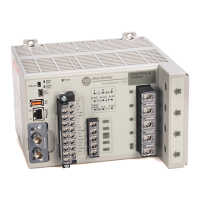Rockwell Automation Publication 1426-UM001J-EN-P - August 2019 191
Logic Functions Chapter 7
Setpoints
A Setpoint tracks the value of a user-selected parameter and when the value meets
user-defined criteria, sets the corresponding Setpoint_Active flag, and executes
an optional user-selected action.
Applications
• M5 model: 10 simple setpoints
• M6 and M8 models: 20 simple or logical setpoints with 10 logic gates
Operation
A PowerMonitor 5000 unit setpoint continually monitors the selected parameter
and evaluates its value against the configured test condition, evaluation types,
threshold, and hysteresis values. The setpoint is armed when the parameter value
satisfies the test condition. A setpoint activates when the setpoint has been armed
for at least the assert delay time. The setpoint is dis-armed when the parameter
value no longer satisfies the test condition (including a dead band that is defined
by the hysteresis value), and de-activates when the setpoint has been dis-armed
for at least the deassert delay time.
Each setpoint can be tied to an output action, such as energizing a relay output or
clearing a value. In the M6 and M8 models, setpoints can also be used as inputs to
up to 10 logic gates, which let you combine setpoints to take specified actions.
The power monitor provides setpoint data including status of each setpoint,
statistics relating to setpoint operations, and a setpoint history log.
See Setpoint and Logic Gate Status
on page 206 for more information.
Evaluation Types
The M5 model provides two evaluation types for setpoints:
• Magnitude - the selected parameter is compared against a fixed value that
you configure in the Threshold tag for the setpoint. Magnitude is the
default selection and is typically used with metering values that are analog
in nature.
• State - the selected parameter is compared against a Boolean value (0…1)
configured by you in the Threshold tag for the setpoint. State is typically
used with discrete parameter values that are either off (0) of on (1).
The M6 and M8 models provide two additional evaluation types:
• Percent of Reference - the selected parameter is compared against a
percentage of a fixed nominal reference value. You configure a nominal
value in the Reference Value tag for the setpoint, and configure the
percentage in the Threshold tag for the setpoint. This evaluation type
operates similar to the Magnitude evaluation type but the power monitor,
rather than you, calculates the percentage of the nominal value.

